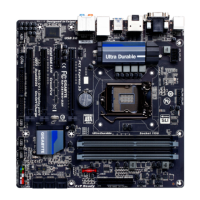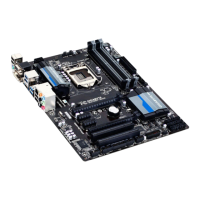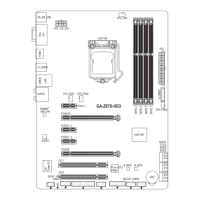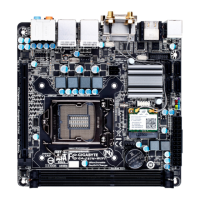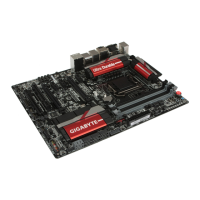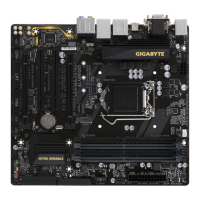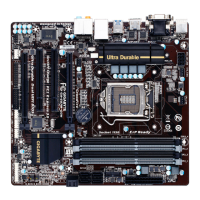
Do you have a question about the Gigabyte GA-Z87M-D3H and is the answer not in the manual?
| ECC | No |
|---|---|
| Non-ECC | Yes |
| Memory voltage | 1.5 V |
| Memory channels | Dual-channel |
| Memory slots type | DIMM |
| Number of memory slots | 4 |
| Supported memory types | DDR3-SDRAM |
| Maximum internal memory | 32 GB |
| Supported memory clock speeds | 1333, 1600 MHz |
| Processor manufacturer | Intel |
| Compatible processor series | Intel Celeron, Intel Pentium |
| Supported processor sockets | LGA 1150 (Socket H3) |
| Maximum number of SMP processors | 1 |
| USB 2.0 connectors | 3 |
| Number of SATA III connectors | 6 |
| Number of Parallel ATA connectors | 0 |
| HDMI version | 1.4a |
| USB 2.0 ports quantity | 2 |
| Audio chip | Realtek ALC892 |
| Cooling type | Passive |
| Component for | PC |
| Power source type | ATX |
| Motherboard chipset | Intel® Z87 |
| PC health monitoring | CPU, FAN, Temperature |
| Audio output channels | 7.1 channels |
| Motherboard form factor | micro ATX |
| RAID levels | 0, 1, 5, 10 |
| Supported storage drive interfaces | SATA, SATA II, SATA III |
| Graphics card | HD Graphics |
| Maximum resolution | 4096 x 2160 pixels |
| Parallel processing technology support | 2-Way CrossFireX |
| PCI Express slots version | 2.0, 3.0 |
| PCI Express configurations | 1x4, 1x16 |
| Cables included | SATA |
| Ethernet interface type | Gigabit Ethernet |
| BIOS type | EFI AMI |
| ACPI version | 2.0a |
| BIOS memory size | 64 Mbit |
| Depth | 225 mm |
|---|---|
| Width | 244 mm |
Guidelines for safely installing hardware, emphasizing ESD prevention and proper handling.
Details on CPU, Chipset, Memory, Graphics, Audio, LAN, Expansion Slots, and Technology.
Instructions and precautions for installing the CPU and its cooler securely.
Guidelines for installing DDR3 memory modules, including Dual Channel configuration.
Procedure for installing expansion cards into PCI Express slots.
Description of various ports on the motherboard's back panel, including USB, HDMI, DVI, etc.
Identification and pinouts for internal motherboard connectors like power, fan headers, and front panel.
Explains the initial GIGABYTE logo screen and function keys for BIOS access.
Details the Windows Mode and Classic Setup interfaces for navigating BIOS settings.
Covers system status, frequency, voltage, and health settings for overclocking and monitoring.
Information on CPU, motherboard model, BIOS version, and system language/time settings.
Configuration options for boot order, security, fast boot, USB, PS/2, and network boot.
Settings for display output, audio controller, SATA configuration, and Super IO.
Options for system resume, ErP, power button behavior, and AC power recovery states.
Procedures for saving/exiting BIOS, loading defaults, and managing profiles.
Steps for installing SATA drives and configuring controller modes (IDE, AHCI, RAID) in BIOS.
Guide for installing Windows 8/7 with RAID/AHCI drivers and rebuilding RAID arrays.
Instructions for installing chipset drivers using the GIGABYTE Xpress Install utility.
Overview of available GIGABYTE utilities and free software for installation.
Access to technical manuals and contact information for GIGABYTE support.
Explains GIGABYTE's Q-Flash and @BIOS tools for updating the motherboard BIOS.
Introduction to GIGABYTE App Center for launching and updating system applications.
Details on using EasyTune for system tuning, overclocking, and fan control.
Overview of EZ Setup applications for simplified system configuration like Disk Mode Switch.
Utility to block specific USB device types on the PC.
Guides on setting up audio, S/PDIF, and microphone recording.
FAQs and a flowchart for system startup issues.

